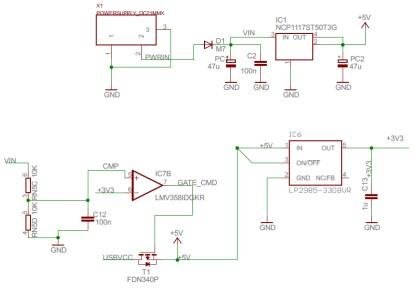Max’s Arduino Mega and chipKIT Max32 both require 9V external supplies, but he really wishes to power them from a single 5V supply.
Well, nothing is simple, is it? I ran into a minor “gotcha” with regard to my Bodacious Acoustic Diagnostic Astoundingly Superior Spectromatic (BADASS) display project. As you may recall from my previous blog on this topic, I’m planning on implementing a 16 x 16 array of tri-colored LEDs using NeoPixel Strips from Adafruit. I’m also planning on controlling these little beauties using an Arduino Mega 2560 R3 microcontroller development board.
 When it comes to processing the audio stream from my iPad to extract its frequency data, which will subsequently be handed over to the Arduino Mega to be displayed, I’m planning on experimenting with a variety of approaches. (See also Linking 2 MCUs with a Home-Grown Interface.) A couple of these approaches will involve a chipKIT Max32 microcontroller prototyping platform.
When it comes to processing the audio stream from my iPad to extract its frequency data, which will subsequently be handed over to the Arduino Mega to be displayed, I’m planning on experimenting with a variety of approaches. (See also Linking 2 MCUs with a Home-Grown Interface.) A couple of these approaches will involve a chipKIT Max32 microcontroller prototyping platform.
The NeoPixel strips require a 5V power supply. Each LED can draw as much as 60mA if all three of its RGB channels are full-on. In reality, it will be rare indeed for all 256 LEDs to be fully on, but I prefer to design for worse-case scenarios. In this case, this would be 60mA x 256 = ~15.6A. In order to accommodate this, I ended up purchasing a 26A highly-regulated power supply as shown below.
Now, the Arduino Mega and the chipKIT Max 32 both require an external supply of between 7V and 12V. When this supply is fed into the board, it is first regulated down to give a constant 5V supply and then regulated down again to provide a 3.3V supply. Alternatively, these boards can also be powered from a USB programming cable, which can provide a 5V supply.
The problem is that things tend to get messy if you are powering each unit from a different supply. Quite apart from anything else, I really don’t want three power cables coming out of the display. Also, if you are using different supplies, then you can’t be sure which sub-unit will power up first and you can end up with one unit back-driving another, which is not generally considered to be an ideal situation.
The bottom line is that I really want everything to be driven from my 26A supply. That way I cut down on the cables and on the power supplies, things are neat and tidy, and everything will power up together.WARNING:
- The following describes some modifications that
I
- decided to make to
my
- microcontroller boards. Please understand that I am
not
- recommending that you do this to your own boards, because you could easily damage them and invalidate any warranties that came with them. (Yes, these are the obligatory weasel words, but it always pays to remember the old saying: “Eagles may soar, but weasels rarely get sucked into jet engines.”)
 Modifying the Arduino Mega
Modifying the Arduino Mega
This is the point where my techno-weenie chum Ivan Cowie leaps into the center of the stage with a cloud of smoke and a fanfare of trumpets. Ivan, whose office is in the next bay to mine, is a diva when it comes to power supplies and their wily ways (which explains why he’s currently writing the All About Batteries mini-series here on EETimes).
Ivan first looked at the PDF schematic diagram for the Arduino Mega. You can access the entire schematic by clicking here, but the relevant portions are shown below:
For more detail: Modifying an Arduino Mega and chipKIT Max32 for 5V Operation
